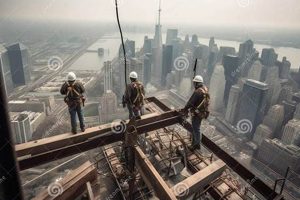When discussing the architectural marvels that grace our skylines, the average skyscraper height often takes center stage as a measure of a city’s economic prowess and engineering capabilities. Skyscrapers, with their towering structures that reach towards the heavens, have become iconic symbols of urban landscapes worldwide, reshaping our skylines and transforming the way we live and work.
The average skyscraper height is not merely a number; it holds immense significance. Taller buildings allow for greater population density within a limited urban footprint, promoting efficient land use and fostering vibrant communities. They serve as vertical cities, accommodating diverse functions such as residential, commercial, and retail spaces, creating thriving ecosystems within a single structure.
Throughout history, the average skyscraper height has steadily increased, driven by advancements in architectural design, engineering techniques, and the relentless pursuit of new heights. From the early skyscrapers of the 19th century to the supertall structures of today, each era has witnessed a new generation of buildings pushing the boundaries of architectural possibilities.
1. Height Measurement
The standardized height measurement for skyscrapers, as defined by the Council on Tall Buildings and Urban Habitat (CTBUH), plays a crucial role in determining the average skyscraper height. This measurement method ensures consistency and accuracy in comparing skyscrapers across different cities and countries, providing a common basis for evaluating their architectural achievements.
Excluding antennas and other non-architectural elements from the height measurement is essential for several reasons. First, it eliminates the influence of temporary or non-permanent structures on the overall height of a building. Antennas, for instance, can vary significantly in height and are often added or modified over a building’s lifetime. By excluding them from the height measurement, we can focus on the architectural design and structural integrity of the building itself.
Furthermore, this standardized height measurement allows for meaningful comparisons between skyscrapers of different architectural styles and purposes. For example, a residential skyscraper may have a different height requirement compared to an office skyscraper, and excluding non-architectural elements ensures that these buildings are evaluated on an equal footing.
In practice, the standardized height measurement is widely used by architects, engineers, and urban planners to determine the average skyscraper height in cities and regions. This information is valuable for various purposes, including urban planning, land use optimization, and architectural research. It also provides a basis for recognizing and celebrating the tallest skyscrapers and the engineering marvels they represent.
2. Global Comparison
When examining average skyscraper height, it is crucial to consider global comparisons, as the height of skyscrapers varies significantly across cities and countries. This variation is influenced by a multitude of factors, including land costs, building codes, and cultural preferences.
Land costs play a significant role in determining the average skyscraper height. In cities where land is scarce and expensive, such as Hong Kong or New York City, developers are incentivized to build taller skyscrapers to maximize the use of available land. This results in higher average skyscraper heights in these cities.
Building codes also impact the average skyscraper height. Building codes are regulations that govern the construction and safety of buildings, including their height. Different cities and countries have varying building codes, which can influence the maximum allowable height of skyscrapers. For instance, cities in earthquake-prone areas may have stricter building codes that limit the height of skyscrapers to ensure structural stability.
Cultural preferences also shape the average skyscraper height. In some cultures, there is a preference for building tall, iconic skyscrapers as symbols of economic prosperity and national pride. This preference can lead to a higher average skyscraper height in these cities.
3. Historical Progression
The historical progression of skyscraper height is inextricably linked to the concept of average skyscraper height. Over time, the average skyscraper height has steadily increased, driven by technological advancements and architectural innovation. This progression is a testament to human ingenuity and the relentless pursuit of new heights.
Technological advancements have played a pivotal role in pushing the boundaries of skyscraper height. The development of new materials, such as reinforced concrete and steel, has enabled the construction of taller and more structurally sound buildings. Innovations in elevator technology have also contributed to the feasibility of skyscrapers, allowing for efficient vertical transportation within these towering structures.
Architectural innovation has gone hand-in-hand with technological advancements in shaping the historical progression of skyscraper height. Architects have continuously explored new design concepts and structural systems to achieve greater heights. For instance, the development of the braced frame structural system in the late 19th century allowed for the construction of taller buildings by providing increased lateral stability.
The practical significance of understanding the historical progression of skyscraper height lies in its implications for urban planning and design. By studying the factors that have influenced the average skyscraper height over time, architects and planners can gain valuable insights into the future trajectory of skyscraper development. This knowledge can informmaking processes related to land use, zoning regulations, and urban infrastructure.
4. Urban Density
In the context of average skyscraper height, urban density plays a crucial role in shaping the built environment of cities. Taller skyscrapers facilitate higher population density within a limited urban footprint, leading to more efficient land use and a more compact city structure.
- Increased Population Capacity: High-rise skyscrapers accommodate a substantial number of residents or workers within a single structure, maximizing the population capacity of urban areas. This is partic
ularly advantageous in densely populated cities where land is scarce and expensive. - Efficient Land Utilization: By building upwards, cities can accommodate more people without sprawling outwards. This efficient use of land preserves valuable green spaces, parks, and other urban amenities, enhancing the overall livability of the city.
- Reduced Urban Sprawl: Taller skyscrapers help curb urban sprawl by concentrating development within existing urban boundaries. This reduces the need for new infrastructure and services in outlying areas, promoting sustainable urban growth.
- Enhanced Connectivity: High-rise buildings often incorporate mixed-use developments, integrating residential, commercial, and retail spaces within a single structure. This creates vibrant and walkable neighborhoods, fostering a sense of community and reducing the need for car-dependent lifestyles.
In summary, the connection between urban density and average skyscraper height underscores the importance of vertical development in accommodating growing urban populations while promoting efficient land use and sustainable urban growth. By embracing taller skyscrapers, cities can create more compact, livable, and economically vibrant urban environments.
5. Architectural Design
Architectural design plays a pivotal role in determining the average skyscraper height. The pursuit of ever-taller buildings requires innovative structural solutions to ensure stability, safety, and functionality.
- Structural Systems: Skyscrapers employ various structural systems to withstand gravitational, lateral, and environmental loads. These systems include braced frames, moment-resisting frames, and core-wall systems, each tailored to the specific height and design of the building.
- Material Innovation: Advancements in material science have significantly influenced skyscraper design. High-strength steel, reinforced concrete, and composite materials enable the construction of taller and more efficient structures.
- Wind Engineering: Wind loads pose a major challenge for skyscrapers, especially in high-rise cities. Architectural design incorporates wind mitigation strategies such as setbacks, aerodynamic shaping, and tuned mass dampers to reduce wind-induced vibrations.
- Seismic Considerations: In earthquake-prone regions, skyscrapers require specialized structural design to withstand seismic forces. This includes base isolation systems, energy dissipation devices, and reinforced concrete shear walls.
These architectural design considerations are crucial for achieving the desired average skyscraper height while ensuring the safety and integrity of these towering structures. By pushing the boundaries of structural engineering and embracing innovative design solutions, architects and engineers continue to redefine the limits of skyscraper height.
6. Economic Impact
The economic impact of skyscrapers extends beyond their physical presence, as they serve as symbols of economic prosperity and can stimulate urban development and growth. The average skyscraper height often reflects the economic vitality of a city or region.
In cities with strong economies, the construction of skyscrapers is often seen as a sign of confidence and optimism. These buildings represent large investments and can attract businesses, residents, and tourists alike. Skyscrapers can also contribute to the local economy by providing jobs during their construction and operation.
Furthermore, skyscrapers can act as catalysts for urban development and growth. They can attract businesses and residents to an area, leading to increased investment and economic activity. The presence of skyscrapers can also make a city more attractive to tourists, further boosting the local economy.
For example, the construction of the Burj Khalifa in Dubai has helped to transform the city into a global tourism and business destination. The building has attracted international attention and investment, and has contributed to the city’s economic growth.
Understanding the connection between economic impact and average skyscraper height is important for urban planners and policymakers. By considering the economic benefits that skyscrapers can bring, cities can make informed decisions about whether to encourage or restrict their construction.
7. Cultural Significance
Cultural significance is a key component of average skyscraper height. Iconic skyscrapers often become landmarks and symbols of a city’s identity and aspirations. They represent the city’s economic power, architectural prowess, and cultural values. For example, the Empire State Building is an iconic symbol of New York City, and the Petronas Towers are synonymous with Kuala Lumpur.
The cultural significance of skyscrapers can have a positive impact on a city’s tourism industry. Tourists are often drawn to cities with iconic skyscrapers, as these buildings offer unique photo opportunities and cultural experiences. For example, the Burj Khalifa in Dubai is a popular tourist destination, and visitors can take a guided tour to the top of the building to enjoy panoramic views of the city.
In addition, skyscrapers can be used to promote a city’s brand and image. For example, the Shanghai Tower in China is designed to resemble a traditional Chinese pagoda, and this design helps to promote the city’s cultural heritage. Similarly, the One World Trade Center in New York City is designed to symbolize the city’s resilience and strength after the 9/11 attacks.
Understanding the connection between cultural significance and average skyscraper height is important for urban planners and policymakers. By considering the cultural impact of skyscrapers, cities can make informed decisions about the design and construction of these buildings. This can help to ensure that skyscrapers are not only functional and safe, but also contribute to the city’s overall identity and appeal.
FAQs on Average Skyscraper Height
This section addresses frequently asked questions (FAQs) on average skyscraper height to provide additional clarity and insights.
Question 1: What factors influence the average skyscraper height in a city?
Answer: Several factors affect average skyscraper height, including land costs, building codes, cultural preferences, technological advancements, and economic conditions.
Question 2: How does average skyscraper height impact urban density?
Answer: Taller skyscrapers allow for higher population density within a limited urban footprint, promoting efficient land use and reducing urban sprawl.
Question 3: What architectural considerations are important for achieving greater skyscraper heights?
Answer: Architectural design plays a crucial role, involving complex structural systems, innovative materials, wind engineering, and seismic considerations to ensure stability and safety.
Questi
on 4: How does the construction of skyscrapers contribute to economic growth?
Answer: Skyscrapers serve as symbols of economic prosperity, attracting businesses, residents, and tourists. They provide employment opportunities and stimulate urban development and growth.
Question 5: What is the cultural significance of skyscrapers?
Answer: Iconic skyscrapers often become landmarks and symbols of a city’s identity, representing its economic power, architectural prowess, and cultural values.
Question 6: How can cities leverage the impact of skyscrapers for urban planning?
Answer: By understanding the factors influencing average skyscraper height and considering their economic, cultural, and environmental implications, cities can make informed decisions about skyscraper development to enhance urban livability and sustainability.
In conclusion, average skyscraper height is a multifaceted aspect of urban development, influenced by a range of factors and carrying significant implications for urban planning and design.
By addressing these FAQs, we aim to provide a comprehensive understanding of this topic and its importance in shaping the built environment.
Now, let’s move on to explore other aspects of skyscraper design and their impact on urban environments.
Tips on Determining Average Skyscraper Height
Accurately determining the average skyscraper height is crucial for urban planning, architectural design, and economic analysis. Here are seven essential tips to guide you in this process:
Tip 1: Define the Measurement Criteria
Establish clear criteria for measuring skyscraper height. Typically, this involves measuring from the base of the building to the architectural top, excluding antennas and other non-structural elements.
Tip 2: Consider Regional Variations
Average skyscraper height can vary significantly across regions. Factors such as land costs, building codes, and cultural preferences influence these variations.
Tip 3: Utilize Reputable Data Sources
Refer to reliable sources, such as the Council on Tall Buildings and Urban Habitat (CTBUH), for accurate and up-to-date data on skyscraper heights.
Tip 4: Exclude Non-Architectural Elements
Ensure that measurements exclude non-architectural elements like antennas and decorative spires, which can inflate the perceived height of a building.
Tip 5: Account for Historical Changes
Recognize that average skyscraper height has changed over time due to technological advancements and architectural innovations. Consider the historical context when analyzing data.
Tip 6: Use Consistent Measurement Methods
Maintain consistency in measurement methods to ensure accurate comparisons between different skyscrapers. Employ standardized measurement techniques as defined by industry organizations.
Tip 7: Consider the Purpose of the Analysis
Determine the purpose of your analysis to guide the selection of appropriate measurement criteria. For instance, economic studies may focus on rentable floor area, while architectural studies emphasize structural height.
Summary:
By following these tips, you can effectively determine the average skyscraper height, providing valuable insights for informed decision-making in urban planning and architectural design.
Transition to the Article’s Conclusion:
Understanding average skyscraper height is essential for various stakeholders, including architects, urban planners, and real estate investors. Accurate measurements and analysis enable informed decision-making and contribute to the creation of sustainable and livable urban environments.
Conclusion
In conclusion, average skyscraper height is a multifaceted concept that encompasses various aspects, each contributing to the overall understanding of these architectural wonders. From height measurement and global comparisons to historical progression and urban density, each element plays a crucial role in shaping the skylines of cities worldwide.
The relentless pursuit of new heights, coupled with advancements in architectural design and engineering techniques, has led to a steady increase in average skyscraper height over time. This vertical growth has transformed cities, allowing for efficient land use, fostering vibrant communities, and serving as symbols of economic prosperity and cultural pride.
As we look towards the future of skyscraper development, sustainability and resilience will become increasingly important considerations. Architects and urban planners must continue to innovate and explore new ways to build taller, more sustainable, and livable skyscrapers that meet the evolving needs of our cities.
Understanding average skyscraper height is not merely about statistics; it is about recognizing the architectural achievements, cultural significance, and economic impact of these iconic structures. By embracing the insights gained from this exploration, we can continue to shape our cities upwards, creating vibrant and sustainable urban environments for generations to come.







